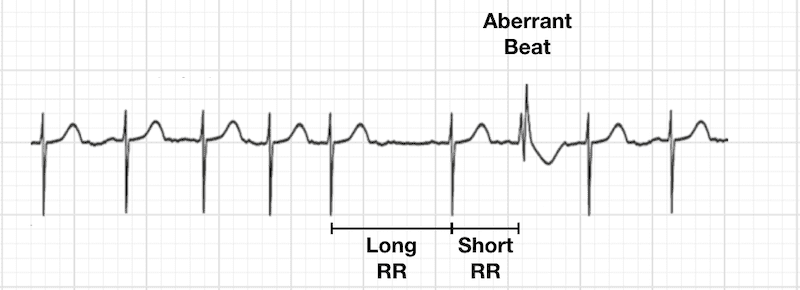Ashman Phenomenon
Description
Ashman phenomenon describes an aberrant ventricular conduction, usually of RBBB morphology, which follows a short R-R interval and preceding relatively prolonged R-R interval
- Typically seen with atrial fibrillation but can also occur with other supraventricular arrhythmias
- Clinically on its own is asymptomatic and does not require any specific treatment

Ashman phenomenon. Occurs when a long RR interval is followed by a short RR interval and terminated by the aberrant QRS complex
History of the Ashman Phenomenon
1947 – Gouaux and Ashman reported that in atrial fibrillation, when a relatively long cycle was followed by a relatively short cycle, the beat with a short cycle often has Right Bundle Branch Block morphology.
1983 – Fisch criteria for the diagnosis of Ashman phenomenon
- Relatively long cycle immediately preceding the cycle terminated by the aberrant QRS complex;
- RBBB-form aberrancy with normal orientation of the initial QRS vector, a series of wide QRS supraventricular beats is possible;
- Irregular coupling of aberrant QRS complexes;
- A short-long-short RR interval is even more likely to initiate aberration; and
- Lack of fully compensatory pause.
Mechanism
The refractory period of the His-Purkinje system is proportional to the RR interval of the preceding beat. So, when two beats are separated by a long RR interval, the subsequent refractory period will be relatively long.
If a premature supraventricular stimulus (short RR interval) follows a long RR interval whilst the His-Purkinje system is still refractory, then the conducted beat will appear abnormal. As the refractory period of the right bundle is slightly longer than the left, the aberrantly-conducted beat typically demonstrates a right bundle branch (RBBB) morphology.
Example


- Richard Ashman (1890-1970)
Alternate Names
- Ashman beat
- Ashman aberrancy
References
- Gouaux JL. Ashman R. Auricular fibrillation with aberration simulating ventricular paroxysmal tachycardia. American Heart Journal. 1947; 34(3): 366-73. [PMID 20262631]
- Fisch C. Electrocardiography of arrhythmias: from deductive analysis to laboratory confirmation–twenty-five years of progress. J Am Coll Cardiol. 1983;1(1):306-16. [PMID 6826940]
- Alraies MC, Eisa N, Alraiyes AH, Shaheen K. The long and short of it: Ashman’s phenomenon. Am J Med. 2013 Nov;126(11):962-3. [PMID 24050488]
- Lakusic N, Mahovic D, Slivnjak V. Ashman phenomenon: an often unrecognized entity in daily clinical practice. Acta Clin Croat 2010;49:99–100.
- Wiesbauer F. Atrial Fibrillation Management Essentials. Medmastery
eponymictionary
the names behind the name
MBBS DDU (Emergency) CCPU. Adult/Paediatric Emergency Medicine Advanced Trainee in Melbourne, Australia. Special interests in diagnostic and procedural ultrasound, medical education, and ECG interpretation. Co-creator of the LITFL ECG Library. Twitter: @rob_buttner

